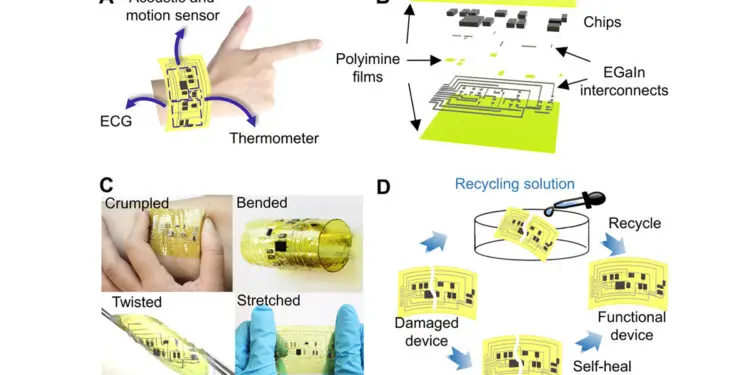Researchers from Shanghai, Beijing university in China and University of Colorado, USA have demonstrated a highly stretchable, self-healable, recyclable, and reconfigurable multifunctional wearable electronic system that can provide physical motion tracking, body temperature monitoring, and sensing of acoustic and ECG signals.
Wearable electronics can be integrated with the human body for monitoring physical activities and health conditions, for human-computer interfaces, and for virtual/augmented reality. We here report a multifunctional wearable electronic system that combines advances in materials, chemistry, and mechanics to enable superior stretchability, self-healability, recyclability, and reconfigurability. This electronic system heterogeneously integrates rigid, soft, and liquid materials through a low-cost fabrication method. The properties reported in this wearable electronic system can find applications in many areas, including health care, robotics, and prosthetics, and can benefit the well-being, economy, and sustainability of our society.
Researchers have demonstrated a highly stretchable, self-healable, recyclable, and reconfigurable multifunctional wearable electronic system that can provide physical motion tracking, body temperature monitoring, and sensing of acoustic and ECG signals. The wearable electronics is realized by electrically interconnecting high-performance, off-the-shelf chip components using LM circuity and encapsulated with a dynamic covalent thermoset polyimine matrix. The wearable electronics can be stretched uniaxially by 60% in both horizontal and vertical directions and biaxially by 30% without affecting the electrical sensing performance. Enabled by the bond exchange reactions in the polyimine network and fluid behavior of the LM circuitry, the wearable electronics can self-heal from damages and can be reconfigured into distinct configurations for different application scenarios. When severely damaged or no longer needed, the wearable electronics can be fully recycled, leading to oligomers/monomers dissolved in methanol, and chip components and LM can be separated from the solution. The recycled solution, chip components, and LM can be reused to make new-generation materials and devices. This work can find applications in many areas, including health care, prosthetics, robotics, and human-computer interfaces, and can benefit the well-being, economy, and sustainability our society.


































